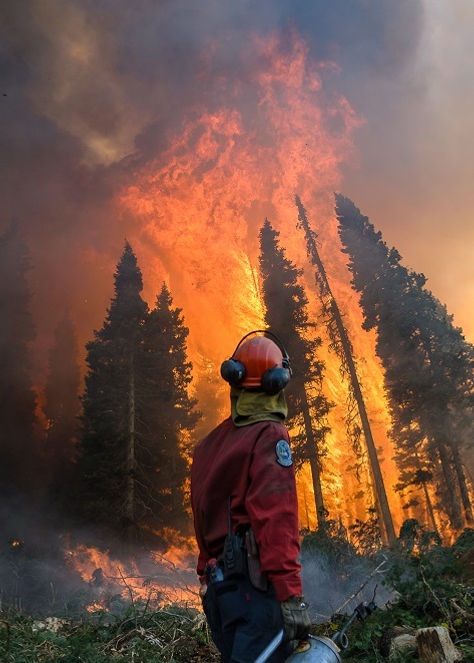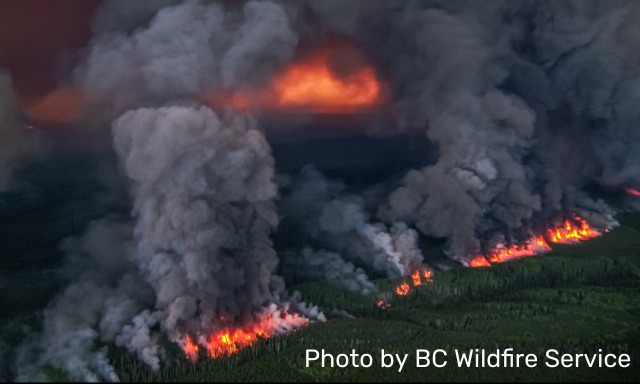Absolute Heat Limits Exist for all Organisms and Machines
Have you ever parked and left your cell phone on the car seat on a hot sunny day? If you have you know that a cell phone will not operate above 35°Celsius (95°F). There are absolute temperature limits for every organism and every engine and computer and electric motor in the world. One of the limits is 37°C (98.6°F). That is the normal temperature of humans. The human body must be able to sweat above that temperature to cool itself so the wet-bulb temperature must stay below 37 degrees. (A wet-bulb temperature combines the temperature and humidity in one measure.) The limit for cats and dogs (38.3°C to 39.2°C) and horses (38.6°C) and Blue Whales (38°C) are all within a degree or two of the human body temperature. Any mammal that is in temperatures above that level will quickly die. As I write there are multiple areas in the world where temperatures are above the levels where humans and other large animals can survive without air conditioning. Similarly, there are temperatures above which electric motors, engines, computers all will stop. The climate crisis is in the first instance not about fossil fuels or about carbon dioxide. The climate crisis is in the first instance about HEAT!
For systems thinkers, we know any system needs a source of energy to operate and that energy is converted to low-grade heat as the system operates. The system also needs a sink to allow it to dump the heat that it generates and if the environment around the system is equal to or higher than the operating temperature of the system, the system will cease to operate. There needs to be a downward gradient between the source and sink. No gradient, operations cease.
Back in February of this year, I outlined how I thought 5 additional blogs in this series would unfold but things have changed since then so I am changing the plan for this final installment. The first thing I am going to do is to tell the truth as I see it. Understanding some basic aspects of the climate crisis will lead us to some specific actions we can take to deal with it. More on that shortly, but first what has changed since February?
The Earth is on Fire
Well, the earth is on fire. This last few weeks across the US southwest there are temperatures as high as 110 to 120 degrees Fahrenheit (43 to 49°C). Remember your body needs to dump heat to someplace cooler than 37°C. There are similar heat waves in Italy and all of Southern Europe and in both India and China. On Tuesday last week Phoenix, Arizona set a record of 19 days in a row with 110°F temperatures.
In Canada, where I live, the story has been about forest fires. In the past, Australia and California have been hit with massive fires. This year it is Canada’s turn. Much of the world doesn’t realize that Canada has the largest intact forest on earth. It is called the boreal forest and stretches 7000 kilometres across Canada covering 60% of this massive country. Every year there are forest fires. But this year by the end of June the area burned was ten times the previous record. These fires have covered not only Toronto with thick smoke but also Chicago, New York, and Washington.

Extreme weather is not unknown in the summertime but many parts of the world experiencing one in a hundred-year events all at once require some explanation.
A New Path Out of the Fire
The earth is on fire – that is a change. But how have I and some of my Common Earth colleagues changed since February? Well, in our ongoing research, we found a new path forward we would not and could not have contemplated in February. We think it is significant enough to call it: A shortcut to solving the climate crisis.Many of you will already have read or heard me speak of what we have found. But what is new here is the logic path we are following from understanding the climate crisis to understanding the action required. Here are 12 aspects of the climate crisis that if understood and believed, (and I do believe them) will lead any person to realize that they can do something about the climate crisis. If a person has that realization and then decides to do nothing – well all I can say is that somehow, we have failed to clearly convey the gravity of the situation we are in.
Watch this 2-minute video to see the last couple of weeks.
1. The Exponential Nature of the Climate Crisis
When we founded Common Earth, we knew the climate crisis is on an exponential growth curve. If the year 2023 is any indication, that growth curve may be moving faster than the climate experts predicted.
Let’s take a moment to understand what we mean by exponential growth. The exponential growth of something occurs when the rate of change is larger than 1 multiplied by the size of the thing itself. So, each time the thing grows, the increment of growth will be larger. Things don’t just grow. They grow at an increasing rate. The product of the world – Global GDP has been growing exponentially for many decades. The growth rate each year is applied to the current GDP so the increment of growth is larger each year. Of course, if the growth rate is a number between 0 and 1 the result is exponentially declining. Systems thinkers would describe this as a reinforcing feedback loop. The causality is circular. All of this can be explained in a simple picture:

The “S” on the two arrows means “same” that is if the element at the beginning of the arrow changes the element at the end of the arrow changes in the same direction. If one grows the other does also. The “R” suggests the loop is a “reinforcing loop.”
2. The Feedback Loops
The biggest thing that makes the climate crisis a reinforcing loop and therefore growing exponentially is the use of fossil fuels. The gases emitted from those fuels are ending up in the atmosphere and creating a growing blanket around earth that keeps much of the outbound heat radiation within the earth’s system. The earth is receiving more energy from the sun than it is putting back out into space. The use of fossil fuels is still growing, thus warming the atmosphere. There are many feedback loops in our current system. For instance, as the arctic lands warm up, the permafrost melts releasing large amounts of methane which is a powerful greenhouse gas. Or as the Arctic warms the sea ice melts lowering the albedo (reflectivity) of the earth. The white ice reflects more sunlight than does the dark blue ocean.
3. The Exponential Growth of GDP
At the same time as humans are thickening the blanket around the earth by using fossil fuels, we are turning up the heat underneath the blanket. That is, we are increasing the amount of energy we are using. To do anything on earth we need to use energy. Growing the GDP of the earth requires more energy. Since the 1960’s humans have doubled the amount of energy we are using twice. If humanity stays on this path of GDP growth resulting in dramatic energy use growth, by 2050 we would be using eight times the 1960s energy and by the turn of the next century, we would be using 32 times the energy we were using in the 1960s.
4. The Exponential Growth of Energy Use
5. The First Law of Thermodynamics
The first law of Thermodynamics tells us that energy can neither be created nor destroyed. So, all this energy we are digging up out of the ground and burning is not going away. Notice that includes nuclear energy. When we came to understand that nature had balanced the energy in the atmosphere and ocean by burying some of it in the ground, we realized how mistaken we were to pull it out of the ground and put it back in the atmosphere. Fossil fuels and nuclear energy including fusion are adding to the heat in the earth system. Wind and solar, once built, are just recycling the energy that we already have in the system.
6. The Second Law of Thermodynamics
The second law of Thermodynamics basically tells us that all this highly useful energy turns into useless low-grade energy that heats up our atmosphere and land and oceans. Up until the last century, the earth has radiated excess energy into space to balance out the energy on the earth. But the process of radiation into space has slowed because of the greenhouse gases. It turns out that the high energy inbound photons can pierce the blanket. But the low-energy photons, trying to leave, often get “caught” by the greenhouse gases.
7. The Sun/Earth/Space Photon Exchange
The high-frequency/short-wavelength inbound photons carry 20 times the energy as the low-frequency/long-wavelength photons being radiated from earth. So, to balance the earth’s energy account earth needs to radiate 20 times the photons that it receives. That’s before we start dumping the heat we are generating.
8. How Greenhouse Gases Interfere with the Photon Exchange
When we started developing the material for Common Earth courses, we didn’t understand how greenhouse gases worked. Why do they heat up the planet but nitrogen and oxygen don’t? Nitrogen at 78% and oxygen at 21% are the predominant gases in the atmosphere so together they are 99%. Why are trace gases like carbon dioxide at .04% and methane, which is even smaller such a problem? Well, greenhouse gases are molecules not individual atoms like nitrogen and oxygen. The atoms in the molecules respond at different rates to the low-grade photons and they heat up and reflect some of this heat back toward earth. To understand this action of molecules we need to dip just a tiny bit into Quantum Mechanics. When atoms get energized, they jump from one energy state to a higher state (a quantum) and each element has its own fingerprint of energy states – that is energy states in which they can exist. When molecules get heated up the atoms of different elements jump to new energy states at different levels of energy. So, the interaction of energy states heats the molecules. The low-frequency low energy photons just happen to be at the correct frequency to agitate the greenhouse gases.
9. Economic System Pushes Towards More Energy and Heat
As we are now seeing, the earth is on a path of exponential growth of energy use and exponential growth of emissions and therefore has exponentially increasing heat. That means that future heat waves will become more common, and more brutal. Corporations are out to maximize profits, so they try to increase their throughput. To feed their growth they need to use more energy. So, our economic system pushes us towards more energy use and more heat.
10. The Act Now Rule
There is a simple iron-clad rule when operating on an exponential curve. That rule is: Act Now! The reason for the rule is that the negative consequences of not acting quickly are increasing at an accelerating rate. In the case of climate, because of the acceleration, the cost of not acting will overwhelm the ability to act. The best example of this rule in practice is if we discover that our house is on fire, we grab the children and get out of the house. We don’t try to rescue Grandmother’s antique chair. You obey the rule, Act Now!
11. The Role of Methane in Global Warming
Methane or CH4 is a powerful greenhouse gas and normally is seen as the most important one after carbon dioxide. The IPCC and others recognize methane as having 28 times more warming potential than CO2 for the same mass of emissions. That is if you are measuring over a 100-year period. Several months ago, my colleague Malene discovered in her research on the topic that if the comparison is done over a 20-year period the ratio is 80 times. This is because methane in the atmosphere has a 12-year life and CO2 has a 1000-year life. So, in the long run, CO2 is more important. However, in the short-term methane is more important. If we want to slow the exponential curve of the climate crisis prioritizing methane makes the most sense.
12. The Role of Cattle in Methane
According to the government and corporate-backed Global Methane Initiative (2020 numbers) cattle and other ruminants accounted for 30% and the oil and gas industry for 24% of methane emissions (see below). Over a period of 12 years or less methane emissions are equivalent to more than all the CO2 emissions. There are approximately one billion cars and one billion cows in the world. The billion cows emit a larger percentage of the total methane emissions than the cars emit of the total CO2. So, in the short run, it is more important to reduce the number of cattle than it is to reduce the number of gasoline-burning cars.

Conclusion: The Short-cut to Solving the Climate Crisis
So, there you have it. The fact that the climate crisis is not just getting worse but is getting worse at an ever-increasing rate, forces us to think of what we can do to slow that pace of growth. Reducing beef consumption is the fastest way to make a difference. This is something we can implement without the permission of the government or without convincing corporations to put the future of the world ahead of this quarter’s profits. This is something we can do the very next time we do our grocery shopping. In other words, we have agency. If we reduce our beef and milk and cheese intake and convince others to take the same steps, then we can make a huge difference in the climate crisis. And once we have taken a big step like this, we should be able to convince ourselves to take additional steps. It was just announced this week that July 2023 has been the hottest month on earth since humans appeared here.




